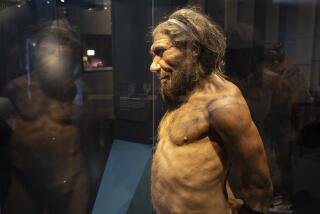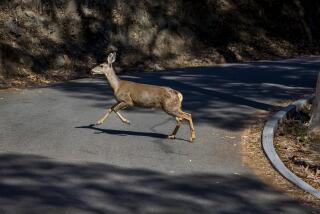BOOK REVIEW : An Examination of the Ethics of the Hunt : A VIEW TO A DEATH IN THE MORNING: Hunting and Nature Through History <i> by Matt Cartmill</i> , Harvard University Press $29.95, 331 pages
- Share via
There was a time just after World War II when it was fashionable to trace the seeds of human aggression to an evolutionary original sin--the need to hunt.
This vision of “man the hunter” was the brainchild of anthropologist Raymond Dart, who in 1925 discovered the fossil bones of Australopithecus (a hominid ancestor) mixed up with the bones of other large animals in a South African cave.
Drawing implications from his find, Dart convinced himself (and many others) that ancestral man had climbed down from the trees in Central Africa and headed for the savannah in a gleeful quest for the culinary pleasures of flesh.
In the 1960s his idea was popularized by Robert Ardrey, who argued that we became bipedal in order to hunt by, say, hurling spears at wild beasts.
Hunting, Ardrey said, led inevitably to the separation of tasks by gender, the formation of nuclear families and the evolution of just about everything else that distinguishes us from non-human animals.
But by the 1970s this “hunting hypothesis” was collapsing under the scrutiny of new anthropologists, many of them female, who read Ardrey’s scenario as just another excuse for subjugation by the Great White Patriarch. More recently, a closer look at the cave where Dart found his fossils has revealed that “man the hunter” was more likely “man the hunted”--the dinner rather than the diner. While hunting is not the single behavior that distinguishes human from ape (especially in light of evidence that chimpanzees also hunt), it is still true that hunting has been part of Western civilization since antiquity.
Thus, how it was celebrated--the etiquette and rationale for the organized chasing, killing and eating of game--becomes an excellent way to examine the nature of our own civilization.
In “A View to a Death in the Morning,” Matt Cartmill, a cultural anthropologist at Duke University, uses the hunt as a mythic metaphor to explain what the hunt has meant in the past and what it symbolizes today.
He explains the rules--the prey must be wild; the death, violent. But at the same time, the hunter must find glory in the hunt, so the prey must be worthy and beautiful. No single creature so fulfills these parameters as deer.
Ancient and medieval artists delighted in capturing the deer’s agony in stone, paint and tapestry. To many Americans today, the deer they identify with most is “Bambi.” By presenting hunting from the victim’s point of view, “Bambi” broke new ground and became powerful anti-hunting propaganda.
A memorable chapter in Cartmill’s splendid book recounts the story behind the film. “Bambi” was originally a novel written in German by an Austro-Hungarian and published in 1924. It caught the eye of the young Walt Disney, who made it the subject of the first feature-length animated cartoon.
Cartmill follows the production, explaining the cinematic conventions created along the way to make the cartoon animals appear sympathetic.
From “Bambi” on screen to stuffed animals in the nursery, Cartmill ruminates on the sudden proliferation of innocent animals and evil humans in 20th-Century toys and books for children.
He finds the roots of this sentimentality in the Industrial Revolution and the emergence of modern science in the 19th Century.
For the first time, the poor and their advocates identified vocally with the animal victims of the hunt. Both were being exploited by the same ruthless upper class.
From this turmoil two social forces emerged: the Humane Movement, which vilified the hunt for its cruelty to animals, and the Conservation Movement, which decried the destruction of animals because they are part of Nature. The first aimed at extending benevolence to animals, the second at preserving what was wild, and assumed good.
The growth of these movements early in this century seemed to indicate that Western culture was getting progressively better.
Cartmill points out that when Dart made his initial discovery about humanity’s aggressive roots, he was generally ignored.
It was not until after 1945, with Auschwitz and Hiroshima suggesting that, on the contrary, humanity was inherently self-destructive, that Dart won attention.
Tool-making, which Dart and Ardrey argue began with making weapons to kill game, led inexorably toward the rest. This misreading of the primeval past leads to what Cartmill labels nicely our present allergy to science.
Cartmill does not enter the animal-rights debate head-on, but he has strong views on the ethics of hunting today. Describing the dilemma of Darwinian reasoning, Cartmill exposes some of our best-loved poets and naturalists in the tangle of their own words.
A determinedly good-natured exploration of a controversial subject, “A View to a Death in the Morning” shows both past and present to be a lot more complicated than the slogans of simplistic ideologues.


